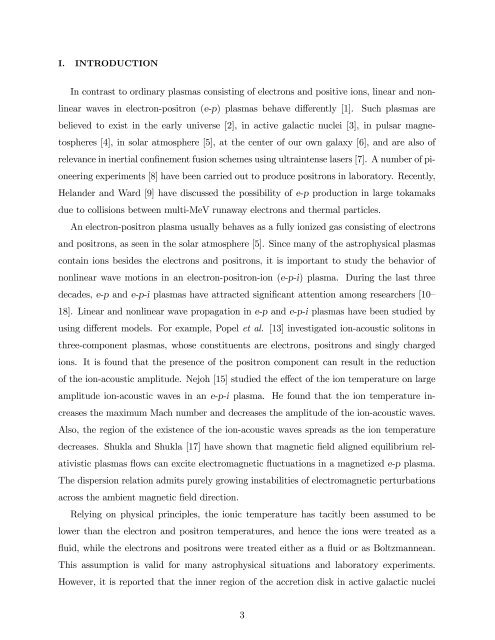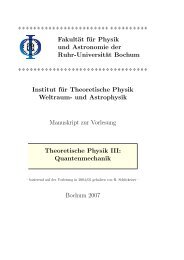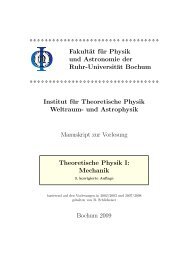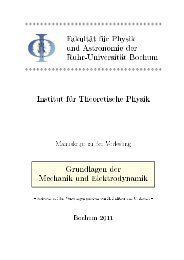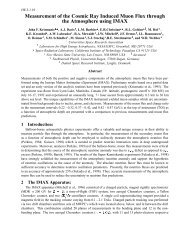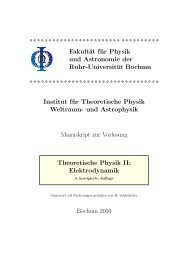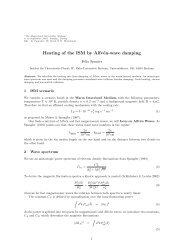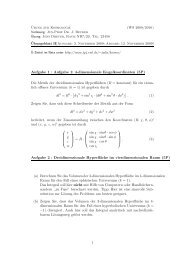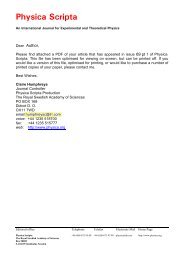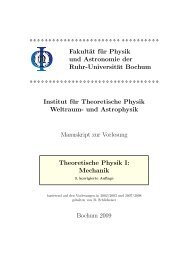pdf here - Theoretische Physik IV - Ruhr-Universität Bochum
pdf here - Theoretische Physik IV - Ruhr-Universität Bochum
pdf here - Theoretische Physik IV - Ruhr-Universität Bochum
You also want an ePaper? Increase the reach of your titles
YUMPU automatically turns print PDFs into web optimized ePapers that Google loves.
I. INTRODUCTION<br />
In contrast to ordinary plasmas consisting of electrons and positive ions, linear and nonlinear<br />
waves in electron-positron (e-p) plasmas behave di¤erently [1]. Such plasmas are<br />
believed to exist in the early universe [2], in active galactic nuclei [3], in pulsar magnetosp<strong>here</strong>s<br />
[4], in solar atmosp<strong>here</strong> [5], at the center of our own galaxy [6], and are also of<br />
relevance in inertial con…nement fusion schemes using ultraintense lasers [7]. A number of pioneering<br />
experiments [8] have been carried out to produce positrons in laboratory. Recently,<br />
Helander and Ward [9] have discussed the possibility of e-p production in large tokamaks<br />
due to collisions between multi-MeV runaway electrons and thermal particles.<br />
An electron-positron plasma usually behaves as a fully ionized gas consisting of electrons<br />
and positrons, as seen in the solar atmosp<strong>here</strong> [5]. Since many of the astrophysical plasmas<br />
contain ions besides the electrons and positrons, it is important to study the behavior of<br />
nonlinear wave motions in an electron-positron-ion (e-p-i) plasma. During the last three<br />
decades, e-p and e-p-i plasmas have attracted signi…cant attention among researchers [10–<br />
18]. Linear and nonlinear wave propagation in e-p and e-p-i plasmas have been studied by<br />
using di¤erent models. For example, Popel et al. [13] investigated ion-acoustic solitons in<br />
three-component plasmas, whose constituents are electrons, positrons and singly charged<br />
ions. It is found that the presence of the positron component can result in the reduction<br />
of the ion-acoustic amplitude. Nejoh [15] studied the e¤ect of the ion temperature on large<br />
amplitude ion-acoustic waves in an e-p-i plasma. He found that the ion temperature increases<br />
the maximum Mach number and decreases the amplitude of the ion-acoustic waves.<br />
Also, the region of the existence of the ion-acoustic waves spreads as the ion temperature<br />
decreases. Shukla and Shukla [17] have shown that magnetic …eld aligned equilibrium relativistic<br />
plasmas ‡ows can excite electromagnetic ‡uctuations in a magnetized e-p plasma.<br />
The dispersion relation admits purely growing instabilities of electromagnetic perturbations<br />
across the ambient magnetic …eld direction.<br />
Relying on physical principles, the ionic temperature has tacitly been assumed to be<br />
lower than the electron and positron temperatures, and hence the ions were treated as a<br />
‡uid, while the electrons and positrons were treated either as a ‡uid or as Boltzmannean.<br />
This assumption is valid for many astrophysical situations and laboratory experiments.<br />
However, it is reported that the inner region of the accretion disk in active galactic nuclei<br />
3


